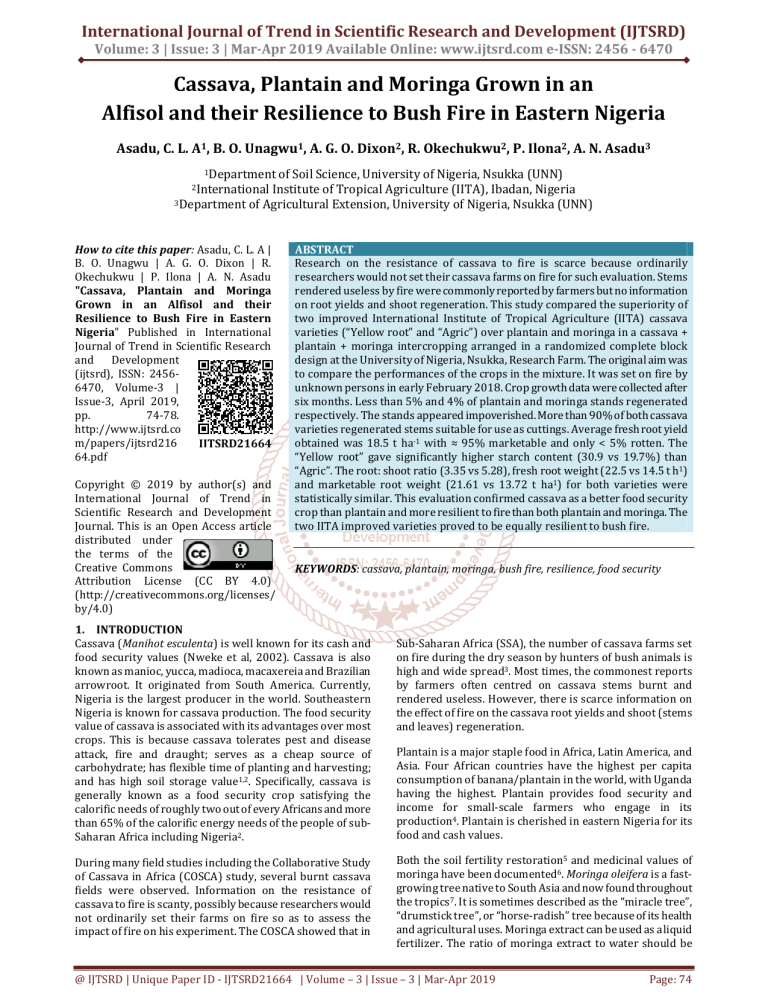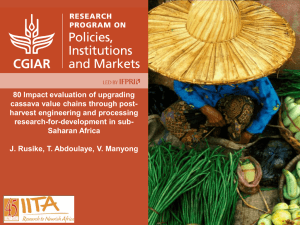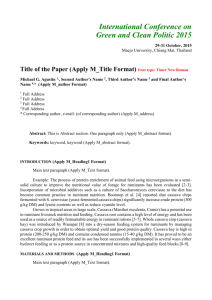
International Journal of Trend in Scientific Research and Development (IJTSRD)
Volume: 3 | Issue: 3 | Mar-Apr 2019 Available Online: www.ijtsrd.com e-ISSN: 2456 - 6470
Cassava, Plantain and Moringa Grown in an
Alfisol and their Resilience to Bush Fire in Eastern Nigeria
Asadu, C. L. A1, B. O. Unagwu1, A. G. O. Dixon2, R. Okechukwu2, P. Ilona2, A. N. Asadu3
1Department
of Soil Science, University of Nigeria, Nsukka (UNN)
Institute of Tropical Agriculture (IITA), Ibadan, Nigeria
3Department of Agricultural Extension, University of Nigeria, Nsukka (UNN)
2International
How to cite this paper: Asadu, C. L. A |
B. O. Unagwu | A. G. O. Dixon | R.
Okechukwu | P. Ilona | A. N. Asadu
"Cassava, Plantain and Moringa
Grown in an Alfisol and their
Resilience to Bush Fire in Eastern
Nigeria" Published in International
Journal of Trend in Scientific Research
and
Development
(ijtsrd), ISSN: 24566470, Volume-3 |
Issue-3, April 2019,
pp.
74-78.
http://www.ijtsrd.co
m/papers/ijtsrd216
IJTSRD21664
64.pdf
Copyright © 2019 by author(s) and
International Journal of Trend in
Scientific Research and Development
Journal. This is an Open Access article
distributed under
the terms of the
Creative Commons
Attribution License (CC BY 4.0)
(http://creativecommons.org/licenses/
by/4.0)
ABSTRACT
Research on the resistance of cassava to fire is scarce because ordinarily
researchers would not set their cassava farms on fire for such evaluation. Stems
rendered useless by fire were commonly reported by farmers but no information
on root yields and shoot regeneration. This study compared the superiority of
two improved International Institute of Tropical Agriculture (IITA) cassava
varieties (“Yellow root” and “Agric”) over plantain and moringa in a cassava +
plantain + moringa intercropping arranged in a randomized complete block
design at the University of Nigeria, Nsukka, Research Farm. The original aim was
to compare the performances of the crops in the mixture. It was set on fire by
unknown persons in early February 2018. Crop growth data were collected after
six months. Less than 5% and 4% of plantain and moringa stands regenerated
respectively. The stands appeared impoverished. More than 90% of both cassava
varieties regenerated stems suitable for use as cuttings. Average fresh root yield
obtained was 18.5 t ha-1 with ≈ 95% marketable and only < 5% rotten. The
“Yellow root” gave significantly higher starch content (30.9 vs 19.7%) than
“Agric”. The root: shoot ratio (3.35 vs 5.28), fresh root weight (22.5 vs 14.5 t h1)
and marketable root weight (21.61 vs 13.72 t ha1) for both varieties were
statistically similar. This evaluation confirmed cassava as a better food security
crop than plantain and more resilient to fire than both plantain and moringa. The
two IITA improved varieties proved to be equally resilient to bush fire.
KEYWORDS: cassava, plantain, moringa, bush fire, resilience, food security
1. INTRODUCTION
Cassava (Manihot esculenta) is well known for its cash and
food security values (Nweke et al, 2002). Cassava is also
known as manioc, yucca, madioca, macaxereia and Brazilian
arrowroot. It originated from South America. Currently,
Nigeria is the largest producer in the world. Southeastern
Nigeria is known for cassava production. The food security
value of cassava is associated with its advantages over most
crops. This is because cassava tolerates pest and disease
attack, fire and draught; serves as a cheap source of
carbohydrate; has flexible time of planting and harvesting;
and has high soil storage value1,2. Specifically, cassava is
generally known as a food security crop satisfying the
calorific needs of roughly two out of every Africans and more
than 65% of the calorific energy needs of the people of subSaharan Africa including Nigeria2.
During many field studies including the Collaborative Study
of Cassava in Africa (COSCA) study, several burnt cassava
fields were observed. Information on the resistance of
cassava to fire is scanty, possibly because researchers would
not ordinarily set their farms on fire so as to assess the
impact of fire on his experiment. The COSCA showed that in
Sub-Saharan Africa (SSA), the number of cassava farms set
on fire during the dry season by hunters of bush animals is
high and wide spread3. Most times, the commonest reports
by farmers often centred on cassava stems burnt and
rendered useless. However, there is scarce information on
the effect of fire on the cassava root yields and shoot (stems
and leaves) regeneration.
Plantain is a major staple food in Africa, Latin America, and
Asia. Four African countries have the highest per capita
consumption of banana/plantain in the world, with Uganda
having the highest. Plantain provides food security and
income for small-scale farmers who engage in its
production4. Plantain is cherished in eastern Nigeria for its
food and cash values.
Both the soil fertility restoration5 and medicinal values of
moringa have been documented6. Moringa oleifera is a fastgrowing tree native to South Asia and now found throughout
the tropics7. It is sometimes described as the “miracle tree”,
“drumstick tree”, or “horse-radish” tree because of its health
and agricultural uses. Moringa extract can be used as a liquid
fertilizer. The ratio of moringa extract to water should be
@ IJTSRD | Unique Paper ID - IJTSRD21664 | Volume – 3 | Issue – 3 | Mar-Apr 2019
Page: 74
International Journal of Trend in Scientific Research and Development (IJTSRD) @ www.ijtsrd.com eISSN: 2456-6470
1:30 when used as a liquid fertilizer. To attain the maximum
yield of most crops, the dilution can be used as the best foliar
applicator to enhance yield because the extract is rich in NPK
along with other nutrients and trace minerals. Moringa leaf
extract applied on the crops does not harm bees, wasps and
butter-flies but helps to control all other pests even rodents7.
Cassava + plantain + Moringa intercrop has been identified
as possible alternative cropping system that can improve
and sustain the income of smallholder farmers in eastern
Nigeria5.
Southeastern Nigeria is known for cassava production. In
February 2018, barely ten months after planting, onehectare cassava + plantain + moringa alley farm established
at the University of Nigeria, Nsukka Teaching Farm which
involved two popular improved IITA cassava varieties grown
by the local farmers (IITA-TMS-IBA070539) also known as
yellow root) and (TMS 30572 also known as ‘Agric’ was set
on fire by unknown person at the peak of dry season. This
fire outbreak necessitated the need to evaluate the effect of
such bush fire on crop resilience vis-a-vis plant survival rate,
regrowth and yield potentials. This study compared the
resilience of cassava, moringa and plantain to bush fire and
the superiority of two cassava varieties involved in the fire
incidence. The yellow variety has a pro-vitamin A content
that averages 10 parts per million (ppm) based on fresh
roots8.
2. MATERIALS AND METHODS
2.1 Location of the Study
Nsukka is located by latitude 060 52’N, longitude 070 24’E
within the derived savanna zone of Eastern Nigerian. The
average elevation of Nsukka area is 447 m above sea level.
The area is dominated by two seasons namely the rainy and
the dry seasons. The former lasts from April to October with
a short break (August Break) normally in the month of
August. Average annual rainfall is about 1550 mm and more
than 85% of this rain falls within the rainy season. The
average minimum and maximum temperatures are about 22
and 30 °C respectively while the average relative humility is
rarely below 60%9. The soil was formed from the residua of
false–bedded sandstone and has been classified as Rhodic
Kandustalf (Haplic Lixisol). Nsukka location meets the
biophysical requirement for the growth of most tree and
arable crops including plantain and moringa10.
2.2 Field establishment
The field was ploughed, harrowed by tractor, and then alleys
of plantain and moringa were established at 5 m apart and 6
m along the alleys in May 2017. Plantain was planted at 9 m
apart and moringa was planted in-between the plantain
stands giving a plant population of 1111 plants ha-1. Ridges
were made by tractor between the alleys and two improved
IITA cassava varieties TMS 30572 known as “Agric” and
IITA-TMS-IBA070539, known as “Yellow root”, in the study
area, were planted at 0.5 m by 1 m giving a plant population
of 20 000 plants ha-1 (Plate 1). Poultry manure was
broadcast at the rate of 8 t ha-1 on the harrowed plots before
ridging. Again, poultry manure was also applied to the
plantain at 0.5 kg stand-1. Both rates approximate farmers’
practice in the area. The two cassava varieties were arranged
in a completely randomized block design (RCBD) replicated
three times. In the second week of February 2018, ≈ 10
months after planting, the entire field was burnt by unknown
persons (Plate 2). The burning was facilitated by the
undergrowth of dry grass and dry portions of the crops.
Plate1: Moringa and plantain planted in one row along one
alley and cassava in the next alley
Moringa
Cassava
Plantain
Plate2. Burnt field of the Cassava + Plantain + Moringa at
UNN in February 2018
2.3 Survival Count of Cassava, Plantain and Moringa
The numbers of cassava, plantain and moringa regenerated
from their burnt stands across the entire field were taken.
Photograph of the regenerated shoots were also captured.
These activities were carried out in the first week of July
2018 approximately six months after burning (6 MAB).
2.4 Cassava Sampling
From the three replicates of cassava plots, three subplots
measuring 5 m x 6 m were carved out for data collection. The
following data were taken: number of regenerated cassava
stands, weight of cassava leaves, weight of plantable stems,
weight of fresh roots, weight of marketable roots and
unmarketable roots as well as that of rotten roots. The starch
contents of the fresh roots of the two cassava varieties were
evaluated in the field using the specific gravity method11. The
set up is shown as Plate 3. The following parameters were
obtained:
Wo = weight of the cassava sample in air
Wu = weight of the sample under water
Sg = specific gravity
BC = basket compensated weight
(BC = weight in air – weight under water)
@ IJTSRD | Unique Paper ID - IJTSRD21664 | Volume – 3 | Issue – 3 | Mar-Apr 2019
Page: 75
International Journal of Trend in Scientific Research and Development (IJTSRD) @ www.ijtsrd.com eISSN: 2456-6470
then
Sg = Wo/ Wo – (Wu + BC)
Starch content = (Sg- 1.00906)/0.004845 %
Plate4: Impoverished regenerated plantain stand at 6 MAB
Plate3. Set up used in estimating the starch content of
fresh root of cassava in the field
2.5 Sorting of Cassava Parameters
2.5.1 Marketable and unmarketable fresh roots
Generally, in Nigeria, cassava markets are bound both in
rural and semi-urban areas. Sorted cassava tubers have
premium price across cassava markets Thus, the weight or
number of marketable roots is more relevant than entire
fresh root yield (unsorted harvest).
Plate 5: Another two impoverished regenerated plantain
stands from the same spot at 6 MAB
Marketable roots have been defined12 as those roots which
are at least15 cm in length. However, we considered those
roots that cannot be held in the hand while peeling (< 10 cm
in length) as unmarketable roots based on agricultural
extension information and local market experience in
Nigeria. Such roots are not, however, useless as they are
crushed and fed to animals by the farmers.
2.5.2 Plantable stems
Plantable stems are those stems from which at least two
viable cuttings of 15 cm long can be obtained before getting
to green part of cassava stem. The green parts of cassava
stem hardly survive when the soil is either dry or wet.
2.5.3 Rotten roots
The rotten roots were sorted and separated from fresh roots
and weighed separately.
3. RESULTS AND DISCUSSION
3.1 Effects of Fire on Crop Survival
The status of the field when the farm was burnt in February
2018 is shown Plate 2. The entire field appeared charred
with no hope of any crop re-growing. The number of plantain
that regenerated at 6 MAB was < 5% of the original stands
(Table 1) and the regenerated stands appeared very
impoverished (Plate 4and 5) as compared with the plantain
stand at the edge of field not affected by fire (Plate 6).
Plate6. Plantain stand at the edge of field not affected by
fire
The effect of fire appeared worse on moringa than on
plantain. This was evident by <4% of the original stands of
moringa that was counted at 6 MAB (Table 1). The moringa
stands also appeared impoverished (Plate 7).
@ IJTSRD | Unique Paper ID - IJTSRD21664 | Volume – 3 | Issue – 3 | Mar-Apr 2019
Page: 76
International Journal of Trend in Scientific Research and Development (IJTSRD) @ www.ijtsrd.com eISSN: 2456-6470
Plate 9: Flourishing TMS 39572 (Agric) at 6 MAB
Plate 7. Impoverished regenerated moringa stand at 6
MAB
3.2
In contrast, the mean number of cassava stands counted at 6
MAB was > 90% (Table 2) and the cassava stands looked
well nourished (Plates 8 and 9).
The results clearly showed the superiority of cassava over
plantain and moringa when subjected to bush fire. This
resistance to fire agrees with established facts that cassava is
a reliable food security crop3,1 . It also raises the hope of
cassava farmers whose farms are subjected to frequent bush
fire by hunters of bush animals.
Plate 8: Flourishing Yellow root at 6 MAB
Comparison of the Resilience of Two IITA Cassava
Varieties to Bush Fire
The data obtained showed that the two cassava varieties
(Agric and Yellow root) did not differ significantly in the
number of stands regenerated at 6 MAB (Table 1). Similarly,
cassava stem, leaf and shoot (above-ground biomass)
weights; and root: shoot ratios associated with the two
varieties did not differ significantly. Although the root
weights of “Agric” and “Yellow root” varieties were
statistically the same, “Yellow root” had 38% higher average
root weight than “Agric” variety. The non-significant
differences in the parameters obtained from the two
varieties at 6 MAB suggest that both varieties have similar
genetic potentials to resist fire. However, the starch content
obtained from “Yellow root” variety was significantly higher
than that obtained from “Agric” by 36%. The significant
difference in the starch content obtained could be attributed
to the variance associated with their inherent genetic
makeup indicating that Yellow root was superior to Agric
with respect to starch content at 6 MAB. Possibly the
fortification of “Yellow root” with pro-vitamin A content that
averages 10 parts per million (ppm) based on fresh roots4 .
(IITA, 2014) may be responsible for the observed differences
in the starch content. This result requires further
investigation.
The average rotten root percentages for “Yellow root” and
“Agric” were 5% and 3% respectively and when compared
statistically there was no difference. This is another
advantage of the varieties. It is, however, possible that the
bush fire killed the microbial organisms that would have
contributed to the rotting of the roots and the organisms
could not repopulate before July when root harvesting was
carried out. This is another area of research challenge
because the expectation would be that a lot of the roots
would have been rotten at 6 MAB the heat from the fire.
Table 1 Effect of bush fire on cassava some re-growth parameters and starch content of two cassava varieties
Number
Stem
Leaf
Shoot
Root
root:
Starch
Variety
Of stands weight
weight
weight
weight
shoot
content (%)
-1
-1
-1
-1
-1
(ha )
(t ha )
(t ha )
(t ha )
(t ha )
ratio
Agric
14 333
4.67
4.28
8.94
14.5
3.35
19.7
Yellow root
15 100
4.44
5.28
9.72
22.8
5.28
30.9
LSD
NS
NS
NS
NS
NS
NS
6.0
Similarly, the number and weight of marketable and unmarketable cassava roots associated with the two varieties did not
differ significantly (Table 2). Plate 10 shows cassava fresh roots sorted into marketable and unmarketable categories.
@ IJTSRD | Unique Paper ID - IJTSRD21664 | Volume – 3 | Issue – 3 | Mar-Apr 2019
Page: 77
International Journal of Trend in Scientific Research and Development (IJTSRD) @ www.ijtsrd.com eISSN: 2456-6470
Table 2 Effect of bush fire on cassava re-grown plantable stems, marketable and unmarketable number, marketable and
unmarketable plant weight of two cassava varieties
Number of
Marketable
Marketable
Unmarketable Unmarketable
plantable
weight of
Number
Weight of
Number of
stems (ha-1) roots (t ha-1) Of roots ( ha-1) Roots (t ha-1)
roots (ha-1)
Agric
33 667
13.7
58 333
0.78
15 567
Yellow root
40 000
21.6
54 000
1.22
18 567
LSD
NS
NS
NS
NS
NS
and Processing Technologies. COSCA Working Paper
No.20.Collaborative Study of Cassava in Africa, IITA,
Marketable roots
Ibadan, Nigeria.
Unmarketable roots
[4] International Institute of Tropical Agriculture, IITA.
2016. Banana & Plantain. Retrieved November 2, 2016,
from http://www.iita.org/banana-and-plantain.
[5] Ndubuaku, U.M. and I.N. Dimelu. 2011. Moringa dishes
and products in Southeastern Nigeria. University of
Nigeria Press, Nsukka. 29pp.
[6] Mercola, J. 2015. The many uses of the mighty moringa
tree.
Retrieved
from
http://wakeupworld.com/2015/09/19/the-many-uses-of-themighty-moringa-tree
Plate10. Cassava sorted into unmarketable and
marketable fresh roots categories at 6 MAB
4. CONCLUSION
The effect of bush fire on plantain, moringa and cassava from
this evaluation was more disastrous on both plantain and
moringa than on cassava. The effects of bush fire on the
regrowth parameters of the two improved cassava varieties,
IITA-TMS-IBA070539 (Yellow Root) and TMS 30572 (Agric)
namely: number of regenerated stands, plantable and
unplantable stems, weight of stems and fresh roots, rotten
roots, marketable and unmarketable fresh roots were
similar. The starch content of “Yellow root” was significantly
higher than that of “Agric”. The resistance of cassava to bush
fire confirms cassava as a better food security crop than
plantain and more resilient to fire than both plantain and
moringa. The two IITA improved varieties proved to be
equally resilient to bush fire. This additional attribute of
cassava raises the hope of cassava farmers whose farms are
often subjected to seasonal bush fire in sub-Saharan Africa
and confirms cassava as a reliable food security crop.
REFERENCES
[1] Asadu, C.L.A. and F.I. Nweke. 1999. The soils of cassavagrowing areas in sub- Saharan Africa. COSCA Working
Paper No 18. Collaborative Study of Cassava in Africa.
RCMD, International Institute of Tropical Agriculture
(IITA), Ibadan, Nigeria.199pp..
[2] Nweke, F.I., Spencer, D.S.C. and J.K. Lynam. 2002. The
cassava Transformation, Africa’s best-kept secret.
International Institute of Tropical Agriculture (IITA),
Ibadan, Nigeria. 273pp
[3] Nweke, F.I., B.O.Ugwu, A.G.O. Dixon, C. L. A. Asadu and O.
Ajobo. 1999. Cassava Production in Nigeria: A function of
Farmer Access to Markets and to Improved Production
[7] Asadu, C. L. A. 2016. Sustaining Biodiversity and
Income against Climate Change through Food Value
Chain System by the Small-Holder Farmers in Southern
Nigeria. Path of Science, [S.l.], v. 2, n. 11, p. 8.1-8.7, Nov
2016.
ISSN
2413-9009.
Available
at:
<http://pathofscience.org/index.php/ps/article/view/
258>. Date accessed: 06 December. 2016. doi:
http://dx.doi.org/10.22178/pos.16-9.
[8] International Institute of Tropical Agriculture, (IITA).
2014. Nigeria releases more cassava with higher provitamin A to fight micronutrient deficiency IITA News
and Events: http://www.iita.org/news-item/nigeriareleases-cassava-higher-pro-vitamin-fightmicronutrient-deficiency/6 July 2014
[9] Asadu, C. L. A. 2002. Fluctuations in the characteristics
of an important short tropical season, 'august break’ in
Eastern Nigeria. Discovery and Innovation, 14(1), 92–
101.
[10] National Horticultural Research Institute (NHRI). 2016.
Cropping systems with Plantain/Banana in Nigeria.
Retrieved from http://banana-networks.org/innovateplantain/files/2013/11/2_presentation-NIGERIA.pdf
[11] Sungzikaw, S. 2008. Determination of starch content of
fresh root of cassava by the specific gravity method.
Workshop on Metrology in Food Safety, Agricultural
Products and Product Safety, Hangzhou, PR China, June
2-6, 2008.
[12] Tan, S. L. and M. Normah 1995. A comparison of
cassava (Manihot esculenta Crantz) varieties Perintis
and MM 92 in relation to cropping duration and soil
type [Perbandingan antara varieti ubi kayu (Manihot
esculenta Crantz) Perintis dan MM 92 berkaitan
dengantempoh penanaman dan jenis tanah], Malaysian
Agricultural Research and Development Institute
(MARDI) Res. J. 23(2) 103–113
@ IJTSRD | Unique Paper ID - IJTSRD21664 | Volume – 3 | Issue – 3 | Mar-Apr 2019
Page: 78





